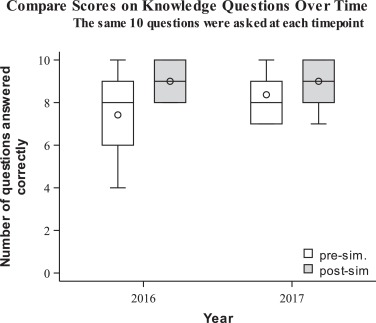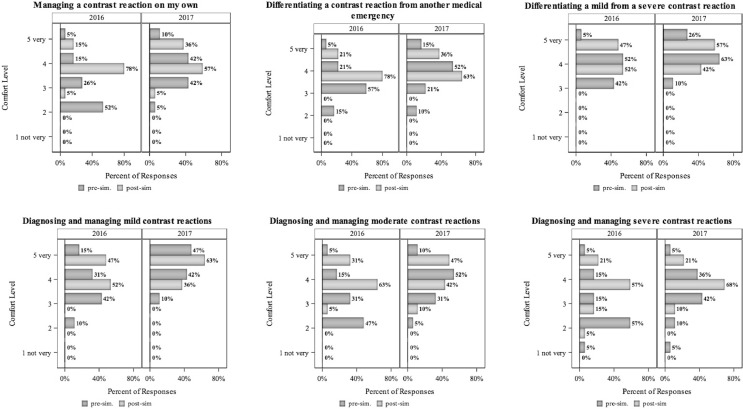Rationale and Objectives
Adverse reactions to intravenous contrast for radiologic examinations can result in significant patient morbidity and mortality. It is critical that radiologists be proficient at recognizing and treating reactions in a timely and appropriate manner. Therefore, we developed a hands-on simulation curriculum to improve residents’ ability and comfort in recognizing and responding to contrast reactions.
Materials and Methods
Contrast reaction management simulations were performed in 2016 and 2017 with 25 and 26 resident participants, respectively. Participants completed pre- and postsimulation surveys both years to assess knowledge and comfort in managing contrast reactions.
Results
In 2016, 25 participants answered 12 questions assessing knowledge of contrast reaction management. Percentage of correct answers increased from pre- to postsurvey in 83% of questions (10/12). Participants indicated their comfort level in managing contrast reactions increased on all six questions from pre- to postsurvey. In 2017, 26 participants answered 14 questions assessing knowledge of contrast reaction management. Similarly, percentage of correct answers increased from pre- to postsurvey in 86% of questions (12/14). Participant comfort levels also increased on all six questions from pre- to postsurvey. Subgroup analysis performed on 19 participants who completed the curriculum both years demonstrated further improvement in knowledge and comfort after completing the second year, showing added benefit of repeated simulation.
Conclusion
These results suggest that incorporating high-fidelity contrast reaction management simulation into resident education improves both residents’ knowledge and comfort in managing reactions. We have therefore incorporated annual contrast reaction simulation as a standard component of our residency curriculum.
INTRODUCTION
Adverse reactions to intravenous contrast administered for radiologic examinations are relatively uncommon, occurring in approximately 0.6% of patients ( ). However, because millions of contrast-enhanced examinations are performed each year in North America, many radiologists will encounter contrast reactions in their career ( ). Moreover, contrast reactions can result in significant patient morbidity and mortality ( ). It is therefore critical that radiologists be proficient at recognizing true reactions and treating patients quickly and effectively when warranted.
Although the radiologist is often the first, and sometimes the only, physician responding to a contrast reaction, his or her comfort level in managing these reactions varies depending on personal experience. Knowledge gaps regarding management of contrast reactions may also exist. A 2014 study found that over 50% of radiologists did not know how to correctly administer epinephrine or the correct dosing to treat a severe contrast reaction ( ). Such knowledge gaps and lack of experience could result in dire consequences for patients undergoing examinations in the radiology department.
Get Radiology Tree app to read full this article<
MATERIALS AND METHODS
Curriculum Development
Get Radiology Tree app to read full this article<
Get Radiology Tree app to read full this article<
Year 1 (2016) Curriculum Implementation
Get Radiology Tree app to read full this article<
Get Radiology Tree app to read full this article<
Get Radiology Tree app to read full this article<
Get Radiology Tree app to read full this article<
Get Radiology Tree app to read full this article<
Get Radiology Tree app to read full this article<
Year 2 (2017) Curriculum Implementation
Get Radiology Tree app to read full this article<
Statistical Analysis
Get Radiology Tree app to read full this article<
RESULTS
Year 1 (2016) and Year 2 (2017) Results
Get Radiology Tree app to read full this article<
Get Radiology Tree app to read full this article<
Get Radiology Tree app to read full this article<
Get Radiology Tree app to read full this article<
Get Radiology Tree app to read full this article<
Sub-group Analysis of Participants From Both Years 1 and 2
Get Radiology Tree app to read full this article<
Get Radiology Tree app to read full this article<
Get Radiology Tree app to read full this article<
Get Radiology Tree app to read full this article<
DISCUSSION
Get Radiology Tree app to read full this article<
Get Radiology Tree app to read full this article<
Get Radiology Tree app to read full this article<
Get Radiology Tree app to read full this article<
Get Radiology Tree app to read full this article<
Get Radiology Tree app to read full this article<
Get Radiology Tree app to read full this article<
DECLARATIONS OF INTEREST
Get Radiology Tree app to read full this article<
Acknowledgment
Get Radiology Tree app to read full this article<
Appendix A
Get Radiology Tree app to read full this article<
Get Radiology Tree app to read full this article<
Get Radiology Tree app to read full this article<
Get Radiology Tree app to read full this article<
Get Radiology Tree app to read full this article<
APPENDIX B:
Get Radiology Tree app to read full this article<
Appendix B
Year 1 Pre- and Postsimulation Contrast Reaction Knowledge Questions ( n = 25)
Survey Question PreSimulation (% Answering Correctly) PostSimulation (% Answering Correctly) % Change Knowledge Overall Average Score 56 70 14
Get Radiology Tree app to read full this article<
56 88 32
Get Radiology Tree app to read full this article<
68 100 32
Get Radiology Tree app to read full this article<
60 88 28
Get Radiology Tree app to read full this article<
68 96 28
Get Radiology Tree app to read full this article<
48 64 16
Get Radiology Tree app to read full this article<
88 80 −8
Get Radiology Tree app to read full this article<
92 100 8
Get Radiology Tree app to read full this article<
88 96 8
Get Radiology Tree app to read full this article<
76 84 8
Get Radiology Tree app to read full this article<
88 92 4
Get Radiology Tree app to read full this article<
12 12 0
Get Radiology Tree app to read full this article<
88 92 4
CT, computed tomography; IV, intravenous; SC, subcutaneous; IM, intramuscular.
Get Radiology Tree app to read full this article<
APPENDIX C:
Get Radiology Tree app to read full this article<
Appendix C
Year 2 Pre- and Postsimulation Contrast Reaction Knowledge Questions ( n = 26)
Survey Question PreSimulation (% Answering Correctly) PostSimulation (% Answering Correctly) % Change Knowledge Overall Average Score
Get Radiology Tree app to read full this article<
62 85 23
Get Radiology Tree app to read full this article<
89 96 7
Get Radiology Tree app to read full this article<
69 92 23
Get Radiology Tree app to read full this article<
85 89 4
Get Radiology Tree app to read full this article<
35 77 42
Get Radiology Tree app to read full this article<
69 89 20
Get Radiology Tree app to read full this article<
85 100 15
Get Radiology Tree app to read full this article<
92 89 −3
Get Radiology Tree app to read full this article<
85 77 −8
Get Radiology Tree app to read full this article<
89 92 3
Get Radiology Tree app to read full this article<
54 89 35
Get Radiology Tree app to read full this article<
85 92 7
Get Radiology Tree app to read full this article<
65 89 24
Get Radiology Tree app to read full this article<
54 77 23
CT, computed tomography; IV, intravenous; SC, subcutaneous; IM, intramuscular; LOCM, low osmolar contrast material.
Get Radiology Tree app to read full this article<
Get Radiology Tree app to read full this article<
References
1. Wang CL, Cohan RH, Ellis JH, Caoili EM, Wang G, Francis IR: Frequency, outcome, and appropriateness of treatment of nonionic iodinated contrast media reactions. AJR Am J Roentgenol 2008; 191: pp. 409-415.
2. ACR manual on contrast media. Version 10.3, 2017: American College of Radiology, ACR Committee on Drugs and Contrast Media; c2017.
3. Wang CL, Davenport MS, Chinnugounder S, et. al.: Errors of epinephrine administration during severe allergic-like contrast re-actions: lessons learned from a bi-institutional study using high-fidelity simulation testing. Abdom Imag 2014; 39: pp. 1127-1133.
4. Picard M, Curry N, Collins H, et. al.: Comparison of high-fidelity simulation versus didactic instruction as a reinforcement intervention in a comprehensive curriculum for radiology trainees in learning contrast reaction management: does it matter how we refresh?. Acad Radiol 2015; 22: pp. 1268-1278.
5. Pfeifer K, Staib L, Arango J, et. al.: High-fidelity contrast reaction simulation training: performance comparison of faculty, fellows, and residents. J Am Coll Radiol 2016; 13: pp. 81-87.
6. Restauri N, Lio E, Glueck D, et. al.: Best practice for safe and effective administration of epinephrine for the treatment of anaphylaxis in the radiology department. J Am Coll Radiol 2016; 13: pp. 303-306.

